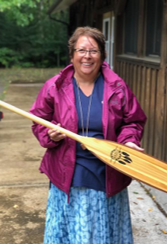Headline News
Algonquin Water Walk coming Sept. 7
August 27, 2024

By Michael Riley
Local Journalism Initiative Reporter
A Water Walk is coming up Sept. 7 at 9 a.m., starting at the Lake of Two Rivers Campground Beach in Algonquin Park (at kilometre 31.8). Organized by the Algonquins of Ontario, the walk is approximately 14 kilometres, and they advise bringing proper footwear, a water bottle and for the women to wear a ribbon skirt or long skirt to honour Mother Earth. Led by Indigenous women, these walks raise awareness of water issues and the importance of clean water for everyone, especially with many Indigenous people on reservations not having access to clean water. A pace vehicle will also be available for those needing rest or unable to walk. A feast will follow the walk. Margaret Haskin comments on this Water Walk and its significance.
Haskin told Bancroft This Week that the planning for the Water Walk on Sept. 7 was going well. She says her daughter Joanne has advertised it on the Mashkiwizii Manido Foundation website, an organization she started and is the executive director of in Pembroke.
“It’s getting good response from there. I think we’ll probably have the biggest Water Walk yet,” she says.
Haskin says that although the walk are mostly women, men can participate. She says they usually have men there to carry their flag and to act as protectors.
“The men’s role, because we like to have balance all the time with our men and women. They make us a feast after [the walk] and they drive the support vehicles that accompany the women on the Water Walk. If a woman can only walk a little way, she can get a ride to the end or you can walk as far as you can, they’ll take you a kilometre up the road and you can rejoin. It’s not a marathon or endurance race,” she says.
The Water Walk starts at the Lake of Two Rivers beach and they start the ceremony there at 9 a.m. and then do the approximately 14 kilometre trek around the lake. Haskin says they’ll shuttle over to Mew Lake to the airfield there, just beyond the bridge where the Madawaska River comes through. She says they’ll do a ceremony there and scoop up the water. Once the water is scooped, they don’t stop, trying to keep the water flowing as if it was still in the river. They do this by passing it around to all the woman participating in the walk.
“So, I’ll get a ride by the East Beach pavilion. So, I’ll be in a canoe so they can pass it off to me in the canoe, because they have to get a shuttle to get over to the bike trail to meet up with me again. My husband usually paddles me very slowly down the river with it. And last year, I had the honour of my great-grandson being in the canoe with me. We got to sing the Water Song a few times going down the river. For me that was so special. When I come up to the bank, one of the ladies takes the water, I catch up with them and we continue back to where we took the water from and put it back in the same spot,” she says.
Haskin says it’s the women’s responsibility to look after the water and by doing the Water Walk, they bring women of all nations together to do the walk, and by doing it on the highway through Algonquin Park, it gives people more awareness of what’s happening with the water.
“And we do water teachings up to the walk. We have cultural water teachings and usually only those that have received these teachings carry the water. We really like our allies to join us because while we’re walking, people like to ask questions and the ones that aren’t carrying the water can stop and talk to them and explain what’s going on. So, the water keepings going and moving as we walk,” she says.
Haskins says that one of the men, during a previous Water Walk, started to cry and said it was like they were feeding off each other’s energy and said it was awesome to see them go as one as they walked.
“It’s a long way, but when it’s finished, we all look at each other and say, oh my goodness, it’s over,” she says.
After the Water Walk, they have a feast that varies from year to year. Haskin says that last year, they had a Moose chili, frybread, desserts and fruit.
“This year, we’ll have pasta with Moose meat and I don’t know what else will go with it. Because we start early, there’s a bag lunch for the women along the way; we have nuts and eggs, and some protein, fruit and stuff like that. It’s pretty cool,” she says.
Water Walks were initially started by Anishinaabekwe grandmother Josephine Mandamin 21 years ago. Back then, she picked up a copper pail which she filled with water and walked around Lake Superior in 2003, Lake Michigan in 2004, Lake Huron in 2005, Lake Ontario in 2006 and Lake Erie in 2007. These walks, led by Indigenous women, raise awareness of water issues and the importance of clean water for everyone, especially with many Indigenous people on reservations not having access to clean water.
Over 10,000 miles have been walked for water along the shores of water bodies in Canada, Central America and the U.S. In 2016, Mandamin was awarded the Lieutenant Governor’s Ontario Heritage Award for her work raising awareness about water conservation and the dangers of fracking, pollution and the bottled water industry.
Haskin says they invite all women to come to the Water Walk on Sept. 7 and make sure they’re comfortable; wear comfortable walking shoes, bring a water bottle (they do have water bottles and ice water to fill the bottles), and she advises them not to bring a backpack, even a small one.
“Even those little backpacks may weigh two pounds, but by the time you finish, it’ll feel like 10 pounds. And dress for the weather, because we walk in any weather, rain or shine,” she says.
Haskins told Bancroft This Week that one of the main stressors for her on the Water Walk is that all women, no matter what nationality or culture they are, are responsible for the water.
“There are so many different teachings of water as well. One of them is water is the first element. We breath the water in our mother’s womb before we breathe air. That’s one thing that I hope people would take away that it’s not a renewable resource. When we do our teachings, we say take a mindful drink of water and they look at us like we have two heads. It means that you take a sip of water and you feel it in your mouth, you feel it going down your throat, you feel it in your stomach and feel what it’s doing to your cells,” she says. “So that mindful sip of water is really thinking of what that water is doing for you.”

















